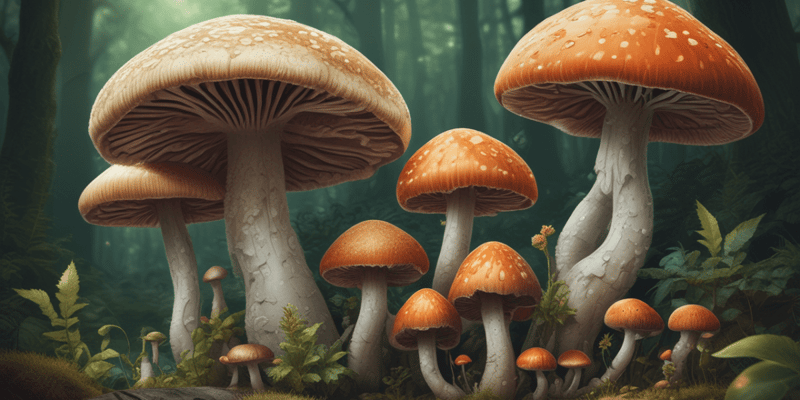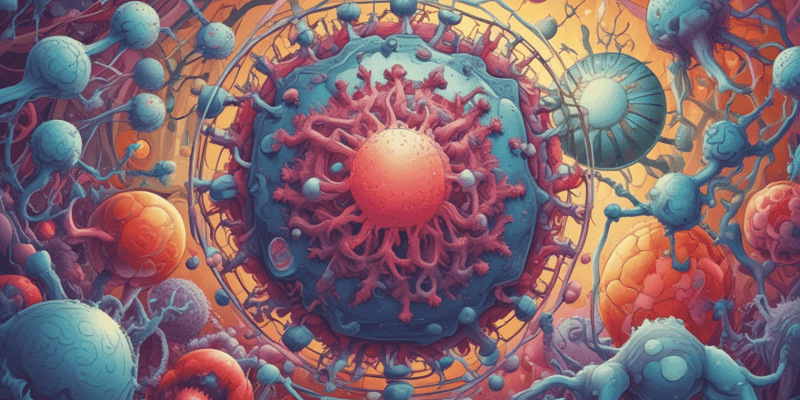20 Questions
What is unique about Candida among fungal infections?
It is part of the normal human mucosal flora
What is the term for the mass of threads with many branches in filamentous fungi?
Mycelium
What is characteristic of the hyphae in some fungi?
They are sometimes septate and sometimes not
How do yeast-like fungi generally reproduce?
By budding
What is unique about dimorphic fungi?
They switch between filamentous and yeast-like forms in response to environmental conditions
What is the main component of fungal cell walls?
Chitin
Why are fungi unaffected by antibacterial antibiotics like penicillin?
Because fungi have a cell wall made of chitin
What is the target of amphotericin B and nystatin in fungal cells?
Ergosterol present in cell membranes
What is the mode of action of imidazole antifungal drugs?
They inhibit ergosterol synthesis by blocking demethylation of lanosterol
What is the primary source of nutrition for fungi?
Soluble nutrients transported across their cell membranes
What is the primary source of nourishment for fungi?
Dead organic matter
How are fungal infections classified?
By the location on or in the body where the infection occurs
What is the term for fungal infections that occur deep within the body or disseminated to internal organs?
Systemic mycoses
What is a characteristic of fungi that distinguishes them from other infectious organisms?
They have a membrane-enclosed nucleus
What is another way that fungi can cause harm to humans, besides infection?
Through their metabolic products
What is the principal means by which fungi reproduce and spread through the environment?
Sporulation
What is the typical pH of Sabouraud dextrose agar?
5.0
What is the purpose of adding antibacterial antibiotics to the medium?
To further inhibit bacterial colony formation
What is the characteristic feature of sexual spores (ascospores)?
They have a characteristic shape and surface ornamentation pattern
What can be used to start fungal cultures?
Either spores or hyphal fragments
Study Notes
Characteristics of Fungi
- Fungi are a diverse group of saprophytic (derives nourishment from dead organic matter) and parasitic eukaryotic organisms.
- They are now generally assigned their own kingdom, Mycota.
- Virtually all organisms are subject to fungal infection.
Classification of Fungal Infections
- Human fungal diseases (mycoses) are classified by the location on or in the body where the infection occurs.
- They are called cutaneous when limited to the epidermis, subcutaneous when the infection penetrates significantly beneath the skin, and systemic when the infection is deep within the body or disseminated to internal organs.
Fungal Metabolic Products
- Fungi produce and secrete a variety of unusual metabolic products, some of which are highly toxic to animals, including humans.
- Fungi can cause poisonings as well as infections.
Characteristics of Fungal Cell Walls and Membranes
- Fungal cell walls are composed largely of chitin, a polymer of N-acetylglucosamine, rather than peptidoglycan.
- The fungal membrane contains ergosterol, rather than the cholesterol found in mammalian membranes.
- These chemical characteristics are useful in targeting chemotherapeutic agents against fungal infections.
Chemotherapeutic Agents
- Amphotericin B and nystatin bind to ergosterol present in cell membranes of fungal cells, forming pores that disrupt membrane function, resulting in cell death.
- Imidazole antifungal drugs (e.g., clotrimazole, ketoconazole, miconazole) interact with C-14 α-demethylase to block demethylation of lanosterol to ergosterol.
- Triazole antifungal agents (e.g., fluconazole, itraconazole) also interact with C-14 α-demethylase to block demethylation of lanosterol to ergosterol.
Habitat and Nutrition
- All fungi are heterotrophs, requiring some preformed organic carbon source for growth.
- Fungi secrete degradative enzymes (e.g., cellulases, proteases, nucleases) into their immediate environment to obtain soluble nutrients.
Modes of Fungal Growth
- Most fungi exist in one of two basic morphologic forms: filamentous mold or unicellular yeast.
- Some fungi are dimorphic, switching between these two forms in response to environmental conditions.
Filamentous Fungi
- The vegetative body, or thallus, of mold-like fungi is typically a mass of threads with many branches, called a mycelium.
- The threads (hyphae) are actually tubular cells that, in some fungi, are partitioned into segments (septate); whereas, in other fungi, the hyphae are uninterrupted by cross walls (no septate).
Yeast-Like Fungi
- Yeast-like fungi exist as populations of single, unconnected, spheroid cells, reproducing by budding.
- Some fungal species, especially those that cause systemic mycoses, are dimorphic, being usually yeast-like in one environment and mold-like in another.
Sporulation
- Sporulation is the principal means by which fungi reproduce and spread through the environment.
- Fungal spores are metabolically dormant, protected cells, released by the mycelium in enormous numbers.
Asexual Sporulation
- Asexual spores (conidia) are formed by mitosis in or on specialized hyphae (conidiophores).
- The color of a typical fungal colony seen on bread, fruit, or culture plate is caused by the conidia.
Sexual Sporulation
- This process is initiated when a haploid nucleus from each of two compatible strains of the same species fuse to form a transient diploid.
- The products of meiosis of this transient diploid become sexual spores (ascospores).
Laboratory Identification
- Most fungi can be propagated on any nutrient agar surface, with the standard medium being Sabouraud dextrose agar.
- Clinical samples may be pus, blood, spinal fluid, sputum, tissue biopsies, or skin scrapings.
Learn about fungi, a diverse group of eukaryotic organisms that derive nourishment from dead organic matter or parasitic means. Understand their classification and pathogenic potential for humans.
Make Your Own Quizzes and Flashcards
Convert your notes into interactive study material.
Get started for free



